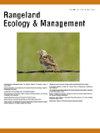Simple Bioassay for Phytotoxic Concentrations of the Herbicide Indaziflam in Soil
IF 2.4
3区 环境科学与生态学
Q2 ECOLOGY
引用次数: 0
Abstract
Indaziflam is a relatively new herbicide that kills newly germinated plants. There is interest in using indaziflam to improve rangeland restoration but applying it around the time of seeding risks damaging seeded plants. A better strategy may be using indaziflam long before seeding to deplete weed seedbanks and then seeding after it dissipates. Dissipation rates vary and are difficult to predict, so testing is needed to determine whether indaziflam remains present. The manufacturer-recommended test involves seeding small indaziflam-treated areas and then monitoring for herbicide damage. A disadvantage here is that rangeland seeding is failure-prone, so seeded species can fail to emerge whether indaziflam is present or not. Another disadvantage is that test areas cannot be reliably evaluated until many months to a year after seeding, by which time evaluations are obsolete. We sought a more reliable, rapid bioassay. We gathered soil samples from nontreated and indaziflam-treated plots in two experiments treated 565 d and 204 d earlier. In these samples in a greenhouse, we planted seeds of native grasses (Elymus lanceolatus [Scribn. & J.G. Sm.] Gould and Pascopyrum smithii [Rydb.] Á. Löve) and an exotic invasive grass (Bromus japonicus Thunb.) and then measured plant responses. Plant densities and heights were similar across experiments. Indaziflam reduced native grass density 50% ± 8%, native grass height 74% ± 6% (mean ±SE), and exotic grass density and height nearly 100% (p < 0.05). The grasses that emerged from treated soil were discolored. Plant data were gathered 18 d after seeding, which illustrates that restoration managers can rapidly test for indaziflam in advance of seeding. To prevent being misled by natural variability among samples, we recommend testing ≥ five nontreated and treated soil samples. In addition to greenhouses, other well-illuminated areas held at 16–24°C are sufficient for testing.
除草剂吲唑吡喃在土壤中植物毒性浓度的简单生物测定
Indaziflam是一种相对较新的除草剂,可以杀死新发芽的植物。人们对使用indaziflam来改善牧场恢复很感兴趣,但在播种期间使用它有损害种子植物的风险。一个更好的策略可能是在播种之前使用茚地夫兰来耗尽杂草种子库,然后在它消散后播种。耗散率各不相同且难以预测,因此需要进行测试以确定茚地夫兰是否仍然存在。制造商推荐的测试包括播种小的茚兹兰处理区域,然后监测除草剂的损害。这里的一个缺点是牧场播种容易失败,因此无论是否存在indaziflam,种子物种都可能无法出现。另一个缺点是直到播种后的许多个月到一年后才能可靠地评估测试区域,到那时评估已经过时了。我们寻求一种更可靠、更快速的生物测定方法。在两个试验中,我们收集了未处理和茚地夫兰处理地块的土壤样品,处理时间分别为565天和204 d。在温室里的这些样本中,我们种植了本地草(Elymus lanceolatus [Scribn.])的种子。,J.G. Sm。[参考译文]古尔德和帕斯考鲁姆·史密斯]。Löve)和一种外来入侵草(Bromus japonicus Thunb.),然后测量植物的反应。不同实验的植物密度和高度相似。Indaziflam使本地草密度降低50% ± 8%,使本地草高降低74% ± 6%(平均 ±SE),使外来草密度和草高降低近100% (p <; 0.05)。从处理过的土壤中长出来的草都变色了。在播种后18 d采集植株数据,说明恢复管理者可以在播种前快速检测indaziflam。为了防止被样品之间的自然变异性误导,我们建议测试≥ 五个未处理和处理过的土壤样品。除了温室外,其他照明良好的区域保持在16-24°C,也足以进行测试。
本文章由计算机程序翻译,如有差异,请以英文原文为准。
求助全文
约1分钟内获得全文
求助全文
来源期刊

Rangeland Ecology & Management
农林科学-环境科学
CiteScore
4.60
自引率
13.00%
发文量
87
审稿时长
12-24 weeks
期刊介绍:
Rangeland Ecology & Management publishes all topics-including ecology, management, socioeconomic and policy-pertaining to global rangelands. The journal''s mission is to inform academics, ecosystem managers and policy makers of science-based information to promote sound rangeland stewardship. Author submissions are published in five manuscript categories: original research papers, high-profile forum topics, concept syntheses, as well as research and technical notes.
Rangelands represent approximately 50% of the Earth''s land area and provision multiple ecosystem services for large human populations. This expansive and diverse land area functions as coupled human-ecological systems. Knowledge of both social and biophysical system components and their interactions represent the foundation for informed rangeland stewardship. Rangeland Ecology & Management uniquely integrates information from multiple system components to address current and pending challenges confronting global rangelands.
 求助内容:
求助内容: 应助结果提醒方式:
应助结果提醒方式:


